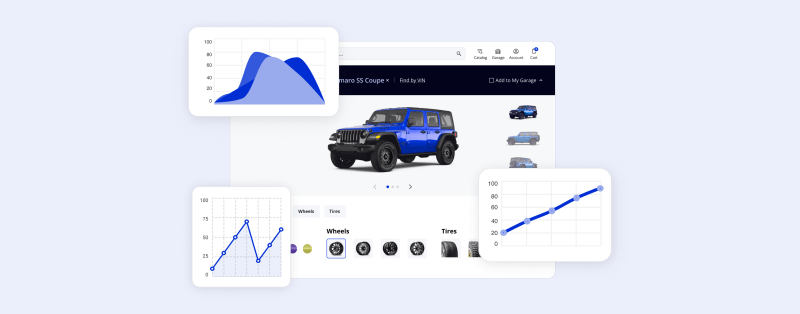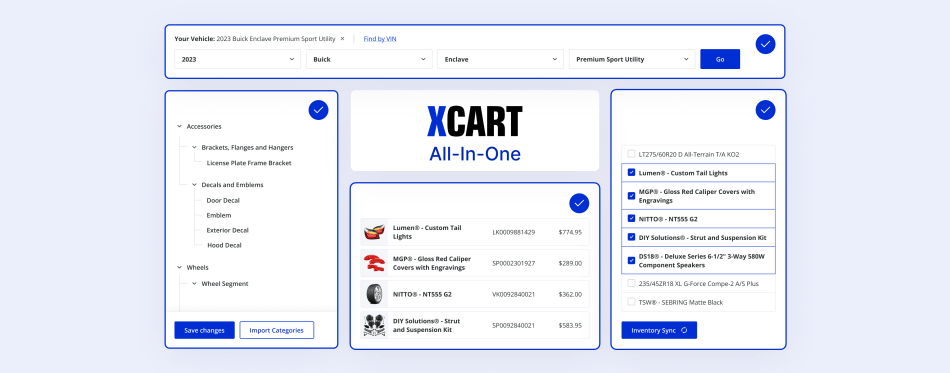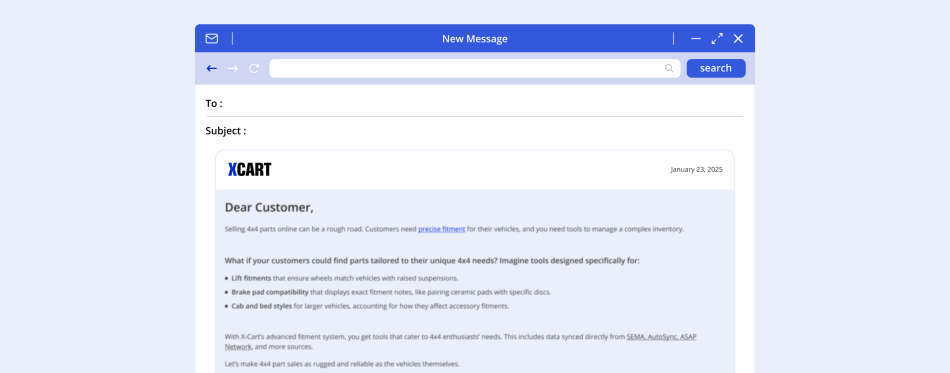Navigating the Shifts in the Automotive Aftermarket Industry: 2023-2025
Today, we are watching the automotive market evolve at breakneck speed. Digital innovation, data accuracy, automation, and rising customer expectations for parts compatibility and fast delivery times are shaping the future of automotive retail yet posing new challenges to auto parts sellers.
But, with that, new growth opportunities pop up, provided that you spot the changes in the market promptly and adjust your business accordingly!
That said, we’ve analyzed what we’ve seen in the past years, including 2023 and 2024, and compiled the hottest auto parts eCommerce facts and predictions for 2025 to navigate you in this highly dynamic landscape.
Rearview Mirror: A Look Back at 2023
With good reason, 2023 was a year of resilience for the automotive aftermarket: we all encountered economic pressures from the pandemic, compounded by supply chain disruptions and rising costs. Despite these hurdles, the U.S. light-duty aftermarket achieved remarkable growth, reaching $392 billion – an 8.6% increase over the previous year. This growth reflected the industry’s ability to adapt and innovate under pressure.
Even during those challenging times, the outlook for the future of aftermarket sales was quite optimistic, and now we can see that most of those predictions have come true.

- Automotive retail started embracing omnichannel. By bridging the digital and physical shopping experiences for their customers, auto parts retailers created opportunities to personalize each auto parts buying journey to best suit a customer’s needs. That said, moving an offline store online was no longer an option, but a necessity dictated by the new normal.
- Customer demand for car parts was at the forefront. Due to the effects inflation had on the cost and availability of new vehicles, namely chip shortages and tightened consumer budgets, auto enthusiasts preferred keeping their old cars running instead of purchasing new ones.
- Government regulations affected the automotive sector. Stricter government car emissions and safety regulations unveiled the need for more environmentally friendly and high-efficiency car parts. So it’s logical that aftermarket parts such as catalytic converters and electronic chips were in high demand as owners invested in their older vehicles to make them more fuel-efficient and ecologically safe.
- Supply chain issues were the biggest challenge. Although the fulfillment rates at auto parts stores improved since the pandemic, some retailers faced supply issues with manufacturers and suppliers trying to fill orders – when a part number was out of stock, it could have taken three to five months to fill all backorders properly.
Automotive Aftermarket in 2024: Staying Competitive in a Shifting Landscape
The trends that took hold in 2023 are not just lingering – they’re evolving. Technological advancements and eCommerce continue to drive the market forward.
🎯 Automation and Supplier Collaboration
Strong relationships with catalog providers and parts distributors are key to ensuring efficient operations. eCommerce integrations eliminate delays in accessing product or data updates, which is especially critical in the automotive aftermarket retail, where timely updates translate into smoother processes and quicker sales.
When automation, standardization, centralized management, and supplier collaboration align effectively, they create a cohesive system that supports adaptability and keeps operations running efficiently.
🎯 Best Selling Auto Parts: Trucks Lead the Charge
Light trucks dominate accessory and performance sales, with pickups (32%), CUVs (15%), and SUVs (12%) driving the industry forward.
Meanwhile, electric vehicles (EVs), though growing in visibility, face adoption hurdles such as limited charging infrastructure and high ownership costs. This has caused some EV owners to consider returning to gas-powered vehicles, adding another layer of complexity to the market.
🎯 Consumer Demands Keep Elevating
Consumer preferences continue reshaping the market. Online shopping for DIY automotive parts is becoming the norm as customers seek convenience, transparent pricing, and fast delivery. Retailers with strong eCommerce platforms and personalized shopping experiences are standing out.

What’s Ahead for 2025?
“May we live in interesting times.”
That old phrase – often cited as a Chinese curse – captures the duality of the coming year. These are undoubtedly interesting times, brimming with both uncertainty and possibility. As we look toward 2025, one thing is clear: staying agile and embracing new tools will be the keys to profitability.
💡Automotive Market Growth Remains Strong
The market shows no signs of slowing down. Growth in the automotive aftermarket is expected to accelerate, propelled by new technologies and shifting consumer habits. Auto parts eCommerce, for example, is projected to grow at a robust 9% annual rate through 2025 as more shoppers prioritize the convenience and cost savings of buying parts online.
Meanwhile, specialty equipment sales are anticipated to hit $52.3 billion, supported by strong wages and a resilient labor market – even with inflation and consumer caution in the background.
💡Auto Parts Manufacturing Expands on a Global Scale
The market is on track to grow at an impressive 6.1% annual rate, valued at over $700 billion in 2023 and potentially reaching $1.19 trillion by 2032. Several factors are driving this growth: steady demand for vehicles, a rising number of aging cars staying on the road, and the hybrid vehicle market, which opens doors to specialized niche-focused parts manufacturing.
Summing Up
Overall, automotive retailers feel optimistic about the future. The demand for aftermarket products is expected to grow in 2025 and beyond. As the industry continues to evolve, the message is clear: change is inevitable, but so is opportunity. For those ready to adapt and innovate, the road ahead looks promising.
Succeeding in the ever-shifting world of automotive eCommerce calls for solutions that can keep up with the pace of change. It’s all about staying ahead of the curve, meeting the needs of the industry, and delivering value to customers in real-time. Solutions like X-Cart are developed to do just that, equipping businesses to thrive in this dynamic environment.
Drive Business Growth with X-Cart
Get a Demo NowWant to See Your Store in Action?
We’ll connect you with a eCommerce expert who can show you the unique features that X-Cart can add to your online automotive store.
About the author









